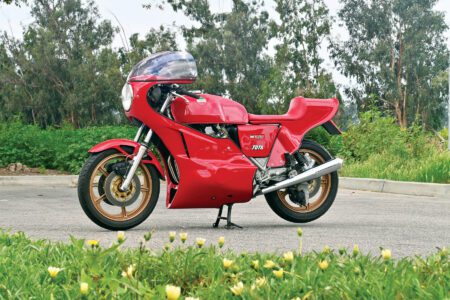So what makes a 180-degree triple different than a 120? Timing, as they say, is everything. On a Laverda 180-degree triple, when the center piston is down the outer two are up. Starting with cylinder no. 1, when that cylinder fires the crankshaft rotates 180 degrees and then no. 2 fires, and another 180 degrees later no. 3 fires. The 4-stroke cycle requires two crankshaft rotations for every firing pulse, so no. 1 doesn’t fire for another 360-degree rotation; it’s like a 4-cylinder engine with one cylinder deactivated. This staggered firing gives the 180 its characteristic lumpy idle.
With crankpins at 120-degree offsets, the number one cylinder fires, then the crank turns 240 degrees and the second cylinder fires, then another 240 degrees and the third cylinder fires, then another 240 degrees and number one fires again; the cycle repeats with no interruption.
The 120-degree triple has a smoother idle than the 180, but it suffers from “rocking couple” generated by the crankshaft spacing. On the 120, no two crank throws are ever in the same position at the same time as on the 180. Further, on a 120 the force exerted by the pistons and rods as they rise and fall in almost stair-step order literally rocks the crankshaft along its longitudinal axis. Modern triples use counterbalance shafts to counter rocking couple. Laverda quelled the forces with engineered rubber mounts. MC
Read more by Robert Smith covering the Laverda 3CL.












